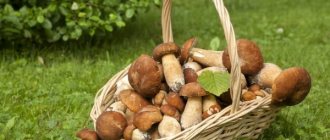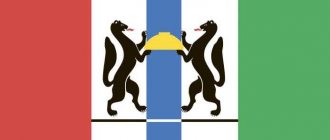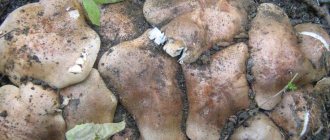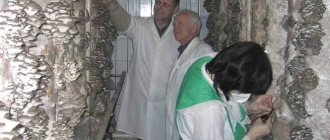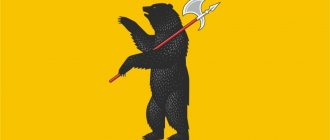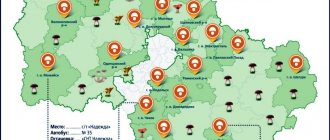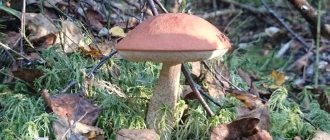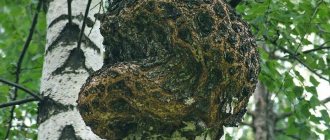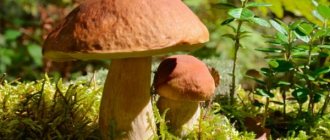In the forests of the central zone, in the mountains of Kamchatka and on the Kola Peninsula, in the forest belts of the North Caucasus and the famous steppes of Kazakhstan, in the regions of Central Asia, more than 300 species of edible mushrooms grow, which lovers of “silent hunting” love to collect.
Indeed, the activity is very exciting and interesting, which also allows you to feast on the harvest. However, you need to know about mushrooms so that poisonous ones do not end up in the basket along with edible ones, which, if eaten, can cause severe food poisoning. Edible mushrooms with photos, names and descriptions are offered for review by anyone interested in collecting mushrooms.
List of forest edible mushrooms with photos and tips for novice mushroom pickers
Mushrooms are considered edible; they can be used as food with absolutely no risk to life and health, since they have significant gastronomic value, are distinguished by a delicate and unique taste; dishes made from them do not become boring and are always in demand and popularity.
Good mushrooms are called lamellar, on the underside of the caps there are lamellar structures or spongy, since their caps on the underside resemble a sponge, inside of which there are spores.
When picking, experienced mushroom pickers always pay attention to special signs that a mushroom is edible:
frequency of the plates;- what color are the spores;
- how the plates are attached to the leg;
- change in color of the pulp when pressing on it.
Forest mushrooms grow from a mycelium that resembles a grayish light mold that appears on a rotting tree. Delicate fibers of the mycelium intertwine the roots of the tree, creating a mutually beneficial symbiosis: the mushrooms receive organic matter from the tree, and the tree receives mineral nutrients and moisture from the mycelium. Other types of mushrooms are tied to tree species, which later determined their names.
The list contains wild mushrooms with photos and their names:
- boletus;
- registry;
- boletus;
- subdukovik;
- pine mushroom;
- speckled oak or common oak, others.
In coniferous and mixed forests there are many other mushrooms that mushroom pickers are happy to find:
During harvesting, it is best to place mushrooms in special wicker baskets, where they can be ventilated; in such a container it is easier for them to retain their shape. You cannot collect mushrooms in bags, otherwise, after returning home, you may find a sticky, shapeless mass.
It is allowed to collect only those mushrooms that are definitely known to be edible and young; old and wormy ones should be thrown away. It is better not to touch suspicious mushrooms at all and avoid them.
The best time to collect is early in the morning, while the mushrooms are strong and fresh, they will last longer.
The best mushroom places in Sochi 2022
23.09.2018 September is traditionally considered the peak of mushroom season.
, but in Sochi the maximum accumulation of mushrooms is most often delayed
to October, and in some cases to November
.
The most popular mushrooms in Greater Sochi: porcini, chanterelles, blackberries, honey mushrooms
are collected in huge quantities and then sent to the kitchen or city shelves. In order not to spend a lot of money on fresh forest products, it is best to collect them yourself. All you need is to make up your mind and go on a hike, guided by simple rules: almost all mushrooms live in the forest, large concentrations of mushrooms are easiest to find at 200 - 400 meters above sea level, we avoid unknown mushrooms, we do not try raw mushrooms, they are wormy , flabby and overripe ones, we don’t cut them off, we don’t pull out the mycelium. Almost done. All that remains is to take with you a knife, a wicker basket, comfortable waterproof shoes and a review of the most mushroom places in Sochi according to SCAPP
Agur Gorge area
The dense, thorny forest and the Agura River create an excellent microclimate for the development of large arrays of mushrooms that just beg to be added to the basket. The main thing is, don’t forget any buckets, boxes, briefcases, bags - if you put mushrooms in this “luggage”, you will bring home cream soup.
Plastunka village area
Near the most Georgian settlement of Sochi (more than half of the residents) there are mushroom forests, which are as saturated as possible after the autumn rains. This autumn has already managed to get us pretty wet, so the hunt for edible caps in Plastunka is open.
Vorontsovka village area
Vorontsovka is geographically located on the Bolshaya Khosta River, and, in addition to the well-known caves, attracts attention with its mushroom deposits. The main thing is not to be fooled by quantity, especially if you are a beginner mushroom picker. If this is your first “catch,” show it to an experienced mushroom picker so that he can confirm that what you have collected can really be consumed.
Galitsyno village area
If you believe the official data, no more than 900 people live here, so we won’t be able to cope with all the mushrooms, we think, and we pack baskets in our “tarantassos”. If this is your first time in Galitsyno or in any other unfamiliar place, do not forget to first study the area using Yandex or Google maps, check the charge on your phone and navigate the terrain.
Zmeykovsky waterfalls area
Near the “tourism duty point” in Sochi, mushrooms are doing well. Now is the active season for porcini mushrooms, a little later chanterelles and blackberries will pop up, and at the end of the autumn season honey mushrooms will ripen. During mushroom ecstasy, we try to think about the future, so we don’t dig up the forest floor, so as not to damage the delicate mycelium. To compensate for the gifts of nature, we sprinkle the deprived leg with soil and it will be possible to return next season for a new harvest.
Other popular places:
- Mount Uspenka,
- Baranovka district,
- Progress village area,
- forest areas near the village of Sergei-Pole,
- mountain village of Medoveevka,
- "goat mountain" area Achishkho
- near the popular Mount Akhun.
Characteristics of edible mushrooms and their description
Among the noble representatives of edible, tasty and healthy mushrooms, there is a special group, which is usually characterized by one word “toadstools”, because they are all poisonous or deadly poisonous, there are about 30 species. They are dangerous because they usually grow next to edible ones and often look similar to them. Unfortunately, only a few hours later it turns out that a dangerous mushroom was eaten, when the person was poisoned and ended up in the hospital.
To avoid such serious troubles, it would be useful to look again at the photos, names and descriptions of edible forest mushrooms before going on a “quiet hunt”.
Where to collect?
Agur Gorge area
The river provides the necessary moisture, the dense forest provides shade. Just an ideal microclimate for mushrooms, which can be found in abundance here.
How to get there?
From the Center of Sochi - by buses: 2 and 122, from the Adler region - by buses: 125 and 105 - to the Sputnik stop.
Plastunka village area
Near the Georgian village there are real treasures for lovers of “silent hunting” - clearings where mushrooms grow in abundance.
How to get there?
By bus number 102 from the city bus station to the final stop “s. Plastunka."
Vorontsovka village area
Not far from the Bolshaya Khosta River you can find clearings that mushroom pickers love - and not without reason.
How to get there?
By bus No. 127 (Khosta - Kalinovoe Lake) - to the final stop.
Galitsyno village area
The area around the village of Galitsyno is also a meeting place for many lovers of “silent hunting”.
How to get there?
Take bus number 131 from Adler to the Kamenka II stop.
Zmeykovsky waterfalls area
The area of Zmeykovsky waterfalls has also been chosen by mushrooms as their habitat.
Description of edible mushrooms with photographs
This description is primarily intended to answer your popular queries about mushrooms: where to collect them, what time of year, what edible mushrooms look like, detailed descriptions with photographs, whether they can be grown at home, what is best to prepare, poisonous and inedible counterparts.
The catalog includes most of the known edible and conditionally edible mushrooms growing on the territory of the Russian Federation. Each description is complemented by an illustrated picture or photograph taken in their natural habitat. In addition, for a complete picture of a particular mushroom, the descriptions are supplemented with excerpts from books, authoritative magazines, reference books and video reviews.
We didn’t find a mushroom here, perhaps it is poisonous or inedible, or it is not yet described on the site and we will be happy to help you identify it.
When do the foxes start coming?
Chanterelles can be collected starting at the end of May. Chanterelles begin to grow actively in early July. Thus, the bulk of chanterelle mushrooms grow from July to the end of September. However, the best time to collect chanterelles is the summer months: July and August.
Interesting materials:
What are carbohydrates? How to do the plank exercise correctly? What is cortisol level? USN and PSN what is it? Dismissal due to reduction, how much salary is paid? What has the most carbohydrates? How to keep a decorative rabbit? What is arginine in? What is protein besides meat? How to store dried apples and pears?
Varieties of mushrooms, inedible and poisonous
Agrocybe mushroom or vole - 2 photos
Agrocybe mushroom or vole among the representatives of this species there are both edible and inedible mushrooms. Inedible ones have an unpleasant odor or bitter taste. Fruits from spring to autumn in soil rich in organic matter or woody ones.
Banker's mushroom dirty-brown-whitish - 2 photos
Banker's mushroom is a dirty-brown-whitish rare mushroom. inedible. Grows in August-September on soil in dry pine forests
Orange oyster mushroom – 4 photos
Orange oyster mushroom, this species can be found all year round on dead deciduous wood; orange oyster mushrooms grow successfully even during winter thaws. The mushroom is listed in the Red Book of the Leningrad Region. Inedible
Mushroom Fiber - 2 photos
Mushroom Fiber There are no edible species among the fibers. The mushroom is inedible or poisonous. These mushrooms are widely represented in our region, growing from spring to late autumn
Mushroom Galerina bordered - 2 photos
Mushroom Galerina fringed is a deadly poisonous mushroom. Contains toxins like the toadstool. It grows on rotten wood and bears fruit from spring to autumn. Inexperienced mushroom pickers may mistake this mushroom for summer honey fungus
Gebeloma mushroom – 2 photos
Gebeloma mushroom, widespread in the forests of the Leningrad region. All types of this mushroom are inedible, there are also mildly poisonous ones. They grow in summer and autumn in different types of forests
Geopora sumneriana mushroom - 11 photos
Geopora sumneriana mushroom
It grows on the Black Sea coast of the Caucasus, the photo was taken in Sochi. It is a cup-shaped mushroom, with small bristles on the outside, very dense, dark brown. The mushroom remains underground for a long time.
Mushroom Hydnellum Blue – 3 photos
The Hydnellum Blue mushroom is inedible. Young mushrooms have a very unusual bluish color of the fruiting bodies
Mushroom Talker – 3 photos
Mushroom Talker It’s strange that a poisonous or inedible mushroom has such an affectionate name. A genus of cap mushrooms from the family Ordinaceae. Small or medium sized mushrooms. They develop in late summer or autumn in forests and parks. In the territory.
Dates for collecting edible mushrooms in 2019-2020
In the Krasnodar region, mushrooms are conventionally divided into spring, summer and autumn. So, when and what varieties are best to collect?
What species are collected in the spring?
The following types of Krasnodar mushrooms are considered spring:
- Oyster mushroom. Local residents call these fruits birch bark. This fungus is considered a parasite because it grows primarily on living deciduous trees, absorbing their nutrients. In appearance, the oyster mushroom resembles “ears” and has a short, almost invisible leg. Mushrooms grow in groups and can sometimes reach surprisingly large sizes. In the Krasnodar Territory you need to look for oyster mushrooms starting in May.
- The golovach is round. This is one of the earliest mushrooms of Kuban. Begins to bear fruit in the second half of April. A rather large fruit that resembles a raincoat in appearance. The main difference between both specimens is that the bighead has a pseudopod, which is actually part of the fruiting body. It is worth considering that the mushroom is considered edible if consumed at a young age.
- The dung beetle is gray. A low mushroom, colored gray. Its cap is initially ovoid, but over time it becomes bell-shaped. There are barely noticeable scales on its surface. In Kuban, this fruit can be found almost everywhere. It is not picky about the soil, but does not settle on clay soil. The fruiting period begins in April.
- Champignon. One of the most revered species of agaric mushrooms not only in Kuban, but also in other territories of Russia. It has fleshy and dense pulp, an attractive mushroom aroma and a rather pleasant taste. A champignon can be recognized by its scaly cap of white or grayish color, ringed leg and pink or brown color of the lamellar area.
- Porcini. A rather fleshy mushroom that has a massive cap and stem. Thus, the size of the cap section can reach 40-50 cm in circumference. The leg is thick and dense. The color of the skin of the mushroom directly depends on the climatic conditions where it grows. The first mushrooms can be found in May, and the end of the fruiting season falls at the end of November.
With the onset of warmer and sunny weather in the Kuban, other edible mushroom specimens begin to appear. It is during this period that the peak of “silent hunting” begins.
Edible summer mushrooms
In the midst of summer heat, the following varieties of fruiting bodies begin to actively appear and reproduce:
- Boletus mushrooms. In Krasnodar, this mushroom begins to actively bear fruit in May. The growing season ends in late autumn. The boletus cap is hemispherical or cushion-shaped. The leg is smooth, covered with scales and widening downward. In Kuban, almost all varieties of these fruits are fleshy and elastic, however, they also have a big disadvantage: they are often wormy.
- Pine mushroom. In Kuban, this fruit is also called delicious saffron milk cap. Despite the name, the color of this specimen is not always red. Often it has greenish or reddish tints. In the Krasnodar region, this species especially loves places in the foothills or slopes of low mountains.
- The breast is real. A large and massive mushroom, the cap of which can be flat, depressed or funnel-shaped. It is white or yellowish in color; when broken or cut, it begins to actively secrete caustic milky juice. You can meet milk mushrooms in mountainous areas, and most often they settle next to hornbeams.
- White truffle. A very rare gift of nature, which cannot be found in all regions of Russia. And the whole secret is that in the Krasnodar region the climate for the growth of these fruits is the most favorable. In appearance, the mushroom looks like an untidy, uneven potato of a grayish or brown color. Truffles are much more difficult to collect than other types of fruit because they are hidden in the soil and require effort to remove.
- Boletus. In the summer, you can collect yellow-brown and red varieties of the mushroom. These are tubular fruits with dense pulp and a massive stem covered with dark scales. The head section is painted yellow, brown, red or brick. The fleshy pulp quickly turns blue when broken or cut. In the Kuban, boletuses grow especially intensively in the forest-steppe and subtropical zones.
- Honey mushrooms. Fungi are saprotrophs, meaning they feed on dead or weakened wood. The fruits are small in size and have a prostrate or convex cap, abundantly covered with scales. Honey mushrooms usually grow in whole groups. The harvest in the Kuban region begins in the first weeks of June, and fruiting ends in November.
It is important! In summer you can easily stumble upon inedible or poisonous specimens. Eating them can lead to poisoning of varying severity. To avoid this, under no circumstances should you touch, smell or taste unfamiliar fruits.
Name of autumn varieties
Among all the existing autumn mushrooms, the following are especially popular among mushroom pickers:
- Violins. These mushrooms can be confused with white milk mushrooms, since both fruits have similar external parameters. The violin's cap is funnel-shaped, pressed in the center. The color is white, there may be brown spots. The fruit can be recognized by its characteristic creaking sound, for which it got its name. In the Krasnodar region, violin grows only in September and October.
- Poplar row. The fruit is distinguished by a convex (in more mature individuals - prostrate) cap of brown or reddish color. Some specimens have spots of a greenish tint. The pulp is dense, elastic, and has a characteristic mealy taste. This is one of the latest Kuban mushrooms. However, such rowing gives a very generous harvest and is widespread throughout the territory.
- Herbaceous scale. Local residents call this fruit golden flake because of the color of its body. The mushroom can be called quite large, since its cap can reach 25 cm in diameter. The color of the scales is yellow, reddish or orange. There is a ring on the leg. This species is considered quite rare; moreover, it can only be found in October. Grows on black soils.
In autumn, the Krasnodar region is completely covered with mushrooms. If in the spring you have to look for suitable places for the sake of “quiet hunting,” then in the fall, thanks to the continued warm weather, you can find edible specimens even in summer cottages or parks.
